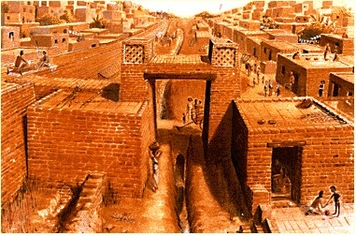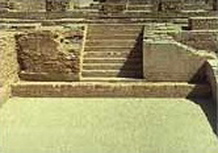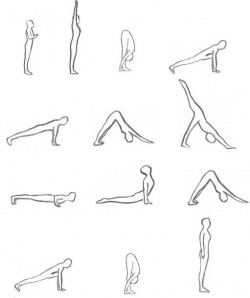History of Yoga

There was nothing primitive about what is now called the Indus-Sarasvati civilization, which is named after two great rivers that once flowed in Northern India; today only the Indus River flows through Pakistan. That civilization’s urbane population enjoyed multistory buildings, a sewage system unparalleled in the ancient world until the Roman empire, a huge public bath whose walls were water-proofed with bitumen, geometrically laid out brick roads, and standardized baked bricks for convenient construction. (We are so used to these technological achievements that we sometimes forget they had to be invented.) The Indus-Sarasvati people were a great maritime nation that exported a large variety of goods to Mesopotamia and other parts of the Middle East and Africa. Although only a few pieces of art have survived, some of them show exquisite craftsmanship.

Now, if the Sarasvati River dried up around or before 1900 B.C.E., the Rig-Veda must be earlier than that benchmark date. If that is so, then the composers of this collection of hymns must have been contemporaneous with the people of the Indus civilization, which flourished between circa 3000-1900 B.C.E. Indeed, astronomical references in the Rig-Veda suggest that at least some of its 1,028 hymns were composed in the third or even fourth millennium B.C.E.
Thus, the Sanskrit-speaking Aryans, who created the Rig-Veda, did not come from outside India to destroy the Indus-Sarasvati civilization. They had been there all along. What, then, was their relationship with the Indus-Sarasvati people? Here opinions still differ, but there is a growing understanding that the Aryans and the Indus-Sarasvati people were one and the same. There is nothing in the Rig-Veda to suggest otherwise.
In fact, the Rig-Veda and the other archaic Sanskrit texts appear to be the “missing” literature of the Indus civilization. Conversely, the archeological artifacts of the Indus valley and adjoining areas give us the “missing” material base of the early Sanskrit literature—an elegant solution to a problem that has long vexed researchers.
Source: http://www.yogalearningcenter.com/articles/short_history_of_yoga
Ashtanga Yoga Style

The popular system of “Ashtanga Yoga” that is widely practiced today, traces its more recent origins back to the very gifted and influential teacher, Sri Tirumali Krishnamacharya. Over an eight-year period of intensive study, in a Himalayan cave at the foot of Mt. Kailash, Sri T. Krishnamacharya studied with his Guru, Rama Mohan Brahmachari. During this time he learned many ancient yogic practices, and memorized several yoga texts, including an ancient manuscript called the Yoga Korunta.
The teachings of the Yoga Korunta, are attributed to the sage Vamana. Little is actually known about this text, but it is said to have contained detailed instruction on both asana and pranayama practices, describing the method of vinyasa (a breath and movement system), drishti (specific gazing points) and bandhas (energetic locks found in the subtle body). Accordingly, the particular sequence of postures that comprise the ‘Ashtanga Yoga’ practice, are thought to have originated from this source.
Sri K. Pattabhi Jois became a student of Krishnamacharya in 1927 at the age of 12. Over the next twenty-five years, he learned and mastered the practices passed on to him by his Guru. Today, these traditional asana sequences are commonly known as the Primary Series (Yoga Chikitsa), Intermediate Series (Nadi Shodhana), and Advanced Series A, B, C, D (Sthira Bhagah Samapta), that make up the ‘Ashtanga Yoga’ practice. In 1948, Pattabhi Jois (Guruji) established the Ashtanga Yoga Research Institute from his home in Laxmipuram, Mysore, with an interest in experimenting with the “curative aspects of yoga.” He began writing the book Yoga Mala in 1958, and completed the manuscript over a three-year period. In the early sixties the first Western yoga students learned of his teachings and came to study with him from Europe. Soon after, in 1973, the first American student, Norman Allen, made his way to Guruji’s home in Laxmipuram, where he began learning the practice of ‘Ashtanga Yoga.’ Today, hundreds of students from all over the world travel to Mysore each year to experience Guruji’s energy and to practice in his presence.
Sri K. Pattabhi Jois took his first trip to the West in 1974, when he was invited to deliver a speech on yoga in Sanskrit, at an international yoga conference held in South America. The following year, sponsored by a group of North American students, Guruji traveled to California with his son Manju Jois. Over the last thirty years, as a result of many trips to different parts of the world, and the efforts of several dedicated students, the teachings and popularity of ‘Ashtanga Yoga’ continue to grow.
Now at 90 years of age, Sri K. Pattabhi Jois remains vibrant, teaching yoga classes daily from his home in Gokulam, Mysore. He is accompanied by his daughter Saraswati, and his grandson Sharath Rangaswamy, Assistant Director of the now well-established Ashtanga Yoga Research Institute. To find out more about Sri K. Pattabhi Jois, or The Ashtanga Yoga Research Institute, you can visit his website at:www.ayri.org.
Source: http://www.livingbreathingyoga.com/History.html
